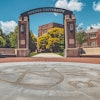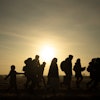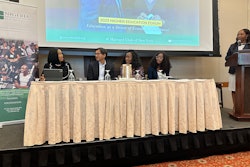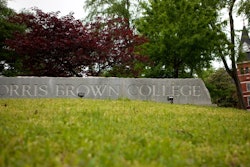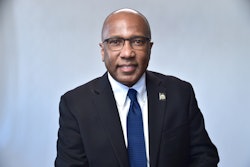DELHI, India — When American artist Gregory Thielker set out to sketch scenes from National Highway 2 — the new superhighway that runs from this capital city to Kolkata — he expected to hear complaints about how construction of the road meant the destruction of homes and temples.
“I had this expectation that when they build one of their massive highways, there’s a lot of loss. Communities and families are disrupted,” Thielker said of his prior notions during a recent interview at his third-floor studio in the Shahpur Jat Village.
“But when I went and started talking to people, it was much different than I thought. … People didn’t really seem to mind,” Thielker said. “They felt the highway means more jobs, more schools, more money, more opportunities.”
That, Thielker said, was one of the most interesting revelations of his journey as a Fulbright scholar, which began last fall when he packed an easel, voice recorder and various art supplies into a driver’s silver 2006 Suzuki Esteem, and set out to sketch whatever there was to draw along the way.
The 918-mile trip, which Thielker made in segments, began at the Old Iron Bridge that stretches over the Yamuna River in Delhi, and it ended at the Ganges River in Kolkata. He printed out a Google map so he would know exactly where he’d be stopping.
Along the way, Thielker sketched a variety of people and places. His sketches, some of them quite striking in detail, range from a truck crash scene to a scar-faced driver with disheveled hair, to things as mundane as a mile marker and a receipt from a guest house in Kolkata.
Thielker sought to get the stories behind the things he sketched and saw. One temple, for instance, was seen as so important that the highway splits to go around it. Some regard it as a special place where wonderful things happen. Others saw it as a cash cow for a local politician.
The road was fraught with peril. One of Thielker’s sketches is of a truck crash, something he says is a much more common occurrence since the highway, also known as Grand Trunk Road, is busier these days.
Danger lingered off the beaten path as well.
In the Bihar state, for instance, Thielker found himself being advised to pick someplace else to draw.
“It was a jungle, a little like a forest to me,” Thielker said. “There was nobody else around. Usually, I would leave the driver and walk alone.”
“And everyone was like, ‘You can’t stop here. It’s not safe. There are gangsters and robbers who come out of the forest and drag people back in and hold them for ransom and rob them.’”
Thielker continued to conduct his interviews and draw a portion of the jungle-lined highway anyway.
“I think this (robberies) used to be more prevalent, especially when the roads were slow,” Thielker said of his rationale for ignoring the warnings.
For the most part, he said, the villagers he met along the way were accepting but curious.
“There were times I did feel a little bit threatened by the curiosity of people,” Thielker said. But his approach was to set up his easel and hope that people could see and respect his dedication to his work.
“I felt like if I was working and they could see what I was doing, I wasn’t just snapping pictures, I was drawing, I was spending a good hour there. I just felt like if I’m working let them look,” Thielker said. “I think that’s why I tried to stay away from showing up, snapping pictures, asking questions and leaving.”
Thielker is still completing his sketches and hasn’t figured out where they will be shown, but he’s considering Washington, D.C., and New York, among other places.
His sketches represent just one way a person can see and experience a new feature of India’s landscape and gain a sense of what it’s like to travel it.
“This project was not going to be about me,” Thielker said. “It’s supposed to be an attempt at what anyone would see or anyone would hear if they travel this road now at this particular time in history.”



